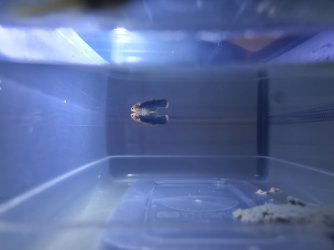So at the beginning of the month brought 6 platy's for my fluval evo sea 52lt.
About a week ago i noticed one of my girls was missing; looked everywhere, in all the caves and where the water goes through the grid to then go through the filter sponge (she had got in there before) no sign of her.
Today i got some ender guppies and moved the sponge to the first compartment so the enders would not get stuck in the first compartment as grid was then blocked by sponge.
Low and behold my missing platy has appeared (she must have some how got into the sponge area, dont know how).
Now to the problem, she seems to have had her tail damaged (looks like its been nibbled off) have seperated her off from the rest of the tank (floated a takeaway box with her in til can get a breeder box tomorrow).
she seems to be having issues swimming down from the surface (before seperated the current was just throwing her around the tank).
Is there any chance she will survive and what can i do to help her if possible.
About a week ago i noticed one of my girls was missing; looked everywhere, in all the caves and where the water goes through the grid to then go through the filter sponge (she had got in there before) no sign of her.
Today i got some ender guppies and moved the sponge to the first compartment so the enders would not get stuck in the first compartment as grid was then blocked by sponge.
Low and behold my missing platy has appeared (she must have some how got into the sponge area, dont know how).
Now to the problem, she seems to have had her tail damaged (looks like its been nibbled off) have seperated her off from the rest of the tank (floated a takeaway box with her in til can get a breeder box tomorrow).
she seems to be having issues swimming down from the surface (before seperated the current was just throwing her around the tank).
Is there any chance she will survive and what can i do to help her if possible.


